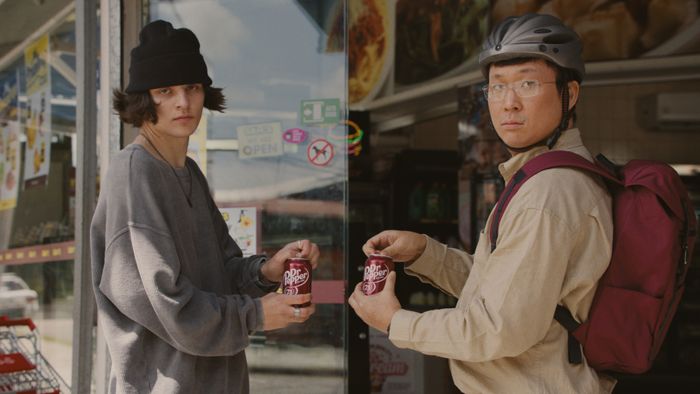
This article is more than
2 year old
After decades as a distant contender, Dr Pepper has climbed the ranks with help from hefty marketing, novel flavors and TikTok videos.
There is a new contender in the cola wars, and it isn’t a cola. It’s Dr Pepper.
The 139-year-old soda brand is now tied with Pepsi-Cola as the No. 2 carbonated soft drink brand in America behind Coke. The regular versions of Pepsi and Dr Pepper are neck and neck in a spot that Pepsi has held nearly every year for the past four decades, according to sales-volume data from Beverage Digest.
Dr Pepper’s new ranking follows a steady climb over the past 20 years. Its ascent is a product of big marketing investments, novel flavors and a quirk in Dr Pepper’s distribution that has put it on more soda fountains than any other soft drink in the U.S. At the same time, consumption of regular Pepsi has fallen as its drinkers switch to Pepsi Zero Sugar or migrate to other drinks.
The overall Pepsi brand, including Diet Pepsi and Pepsi Zero Sugar, remains the No. 2 soda trademark in the U.S., though its market share has been slipping. Coke is the largest, with more than twice the market share by volume of any of its rivals.
Dr Pepper is one of the oldest soda brands in the U.S.—older than Coca-Cola or Pepsi. It was invented in 1885 by Charles Alderton, a young pharmacist and soda-fountain operator who wanted a drink that evoked the aroma of the drugstore where he worked in Waco, Texas.
His syrup concoction combined 23 flavors, including cherry and vanilla, along with other fruits and spices. Coca-Cola was invented a year later, followed by Pepsi-Cola in the 1890s.
Coca-Cola emerged as the most popular fountain drink, while Dr Pepper retained a stronghold in the Southern states. The cola wars began in the 1960s, when PepsiCo PEP 1.42%increase; green up pointing triangle launched its Pepsi Generation campaign. It cast Pepsi as the hip, upstart cola for young people and Coke as staid and old-fashioned.


Pepsi didn’t catch Coke, but it reached a close second. Pepsi-Cola has held the No. 2 spot nearly every year since 1985, when Beverage Digest began collecting data, except for a stretch from 2010 to 2013, when Diet Coke unseated regular Pepsi to grab second place.
The $97 billion U.S. soft drink market is largely organized into red and blue camps, representing the packaging colors of Coke and Pepsi. Each has its own distribution network, and each competes for national restaurant chains like McDonald’s and Wendy’s.
Dr Pepper, which is owned by Keurig Dr Pepper KDP 1.03%increase; green up pointing triangle, has alliances with both sides. Whether you encounter a soda fountain with Coke brands or Pepsi brands, it probably has Dr Pepper on it, too. That ubiquity has helped introduce Dr Pepper to more and more people, said Keurig Dr Pepper’s chief marketing officer, Andrew Springate, who has worked with the brand for the past two decades.

In 2004, Dr Pepper was tied with Sprite in sixth place. Its market share has climbed steadily since then. During that time, Springate said, the brand has kept a consistent marketing theme, focusing on Dr Pepper’s unique taste. Dr Pepper’s substantial marketing spending includes large investments in college football, including its Fansville advertising campaign, he said. Dr Pepper now has strong sales across the country and is growing fastest among Gen Z drinkers, Springate said.

Consumer surveys showed that people like to drink Dr Pepper as a treat, so the brand has leaned into the idea of a sweet indulgence, he said. Noting a trend of younger consumers’ seeking out unusual flavors, Dr Pepper has introduced such variations as strawberries and cream to attract new drinkers. Some of them then become fans of traditional Dr Pepper, he said. The new flavors have also proven popular among Hispanic consumers, a growing demographic in the U.S.
On TikTok, viral videos show young people filling Stanley Quencher cups with ice and Dr Pepper. They also show such concoctions as Dr Pepper with pickles and the Dirty Dr Pepper, a mix of Dr Pepper, lime juice, coconut-flavored coffee creamer and optional liquor. The brand riffed on this idea and introduced a canned, nonalcoholic version called Dr Pepper Creamy Coconut.
Daryl Allen, 41, a blogger in Seattle who likes to experiment with Dr Pepper combinations, recently tried what he called a Dr Peperoncini. He topped a glass of the soda with three hot peppers and downed the whole thing.
“It was not as good as the dill pickle one,” he said.
A Dr Pepper fan since childhood, Allen said he loves the soda’s pleasantly medicinal flavor and counterculture vibe. When told that Dr Pepper is now tied with Pepsi as America’s second-biggest soda brand, he replied with an expletive.
“That’s awesome!” he said. “It’s such an underdog story.”

Write to Jennifer Maloney at Jennifer.Maloney@wsj.com